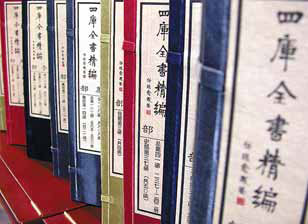Scholars leaf through emperor's encyclopedia online
Updated: 2013-11-05 07:12
By Li Yao in Hong Kong (China Daily)
|
||||||||
It was the brainchild of Emperor Qianlong: Siku Quanshu, or The Complete Books of the Four Imperial Repositories. Qianlong, who sat on the imperial throne during the Qing Dynasty (1644-1911), set himself the task of preserving and restoring Chinese culture.
In 1773, he began to carry out his unparalleled ambition to compile the world's largest encyclopedia. It was to be the signature achievement of his reign.
The encyclopedia contains vast records that reveal how people lived in bygone days: their aspirations, yearning, worries and day-to-day trials. Even the ways people found entertainment and hobbies show how little people have changed.
Thousands of scribes toiled for more than 10 years, brush pens in hand. Word by word, they copied some 3,000 works selected for the grand compilation.
The emperor was pleased with the completed work and demanded the preparation of six more copies. Those were distributed to important libraries, and from there, became swept up in the tide of history. Some were burned, some were pillaged in the wars and rebellions that plagued the nation during years of upheaval. Some were damaged while being relocated.
The copy that Qianlong sat reading survived and resides today in the National Palace Museum in Taipei. The other three surviving copies are kept in Beijing, Lanzhou and Hangzhou.
Today, accessing the hand-written copies is a rare privilege for a few scholars. But the complete encyclopedia may be viewed online. Digital Heritage Publishing, a Hong Kong company, developed an electronic version that is available through subscription.
As China studies have gained momentum globally, the electronic Chinese encyclopedia has drawn subscriptions from 794 universities and research institutes in 20 countries.
The number is continuing to grow with new subscribers just recently from Belgium, New Zealand, Israel and Malaysia.
Gabriel Yu, the publisher, has invested HK$50 million ($6.45 million) in the digitizing effort. He hired 200 programmers to create a pool of 80,000 Chinese characters that can be recognized and typed on computers.
The technique, optical character recognition, converts scanned images of the handwritten texts into computer-encoded data entries. It allows electronic searches and common word processing features: highlighting, bookmarking, copying and pasting.
The sheer volume of the historical collection is overwhelming. No one ever has claimed to have read the complete body of works. There's no question of its value for academic research. Scholars don't have to pore over library catalogues to find material on given topics.
Dai Longji, curator at the Macau University of Science and Technology, says the digital Siku Quanshu is popular among professors and students.
"Students are more tech-savvy. With the digital version, they find more study materials. The professors became challenged by these well-read students and had to catch up with the electronic sources," Dai says.
Steve Ching, librarian at the City University of Hong Kong, will soon open a study center dedicated to ancient Chinese texts. There, Ching promises a quiet space and an engaging atmosphere that he hopes will encourage professors and students to sit and savor the works of ancient sages.
Ching expects interest from more than professors studying history, Chinese language and philosophy. Teachers and students from engineering, business, agriculture and medical schools will also be encouraged to use the facility. The encyclopedia includes titles in all those fields.
Richard Wong, a second-year law student, makes frequent reference to the digital Siku Quanshu. Wong practices Chinese calligraphy, and believes his work requires a thorough understanding of the original roots of his calligraphy interpretations.
He's especially fond of Sun Tze's Art of War. The parallels between the past and the present day fascinate him.
"In war, there are no fixed situations, as water has no constant shape," says Wong citing a famous line of Sun Tze's work. "Those who can adapt to the changing conditions of the enemy and win may be considered legendary in warfare.
"It sounds so familiar in today's business world. It tells us how to deal with market competitors," Wong says.
liyao@chinadaily.com.cn
|
The digitized form of Siku Quanshu may help more people better understand Chinese traditional culture. Provided to China Daily |
(China Daily 11/05/2013 page22)

 Post-baby Duchess
Post-baby Duchess
 Victoria Beckham S/S 2014 presented during NYFW
Victoria Beckham S/S 2014 presented during NYFW
 'Despicable' minions upset Depp's 'Lone Ranger' at box office
'Despicable' minions upset Depp's 'Lone Ranger' at box office
 'Taken 2' grabs movie box office crown
'Taken 2' grabs movie box office crown
 Rihanna's 'Diamonds' tops UK pop chart
Rihanna's 'Diamonds' tops UK pop chart
 Fans get look at vintage Rolling Stones
Fans get look at vintage Rolling Stones
 Celebrities attend Power of Women event
Celebrities attend Power of Women event
 Ang Lee breaks 'every rule' to make unlikely new Life of Pi film
Ang Lee breaks 'every rule' to make unlikely new Life of Pi film
Most Viewed
Editor's Picks

|

|

|

|

|

|
Today's Top News
Gunfire reported in New Jersey shopping mall
Obama asks supporters to save health care plan
New York Chinese Film Festival kicks off today
DuPont expands Shanghai R&D center
Merkel says US ties must not be put at risk
Opening ties with China remembered
Biden headed to East Asia
White House dismisses Snowden's clemency plea
US Weekly

|

|








